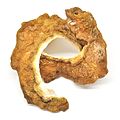Kaffir lime
Kaffir lime (Citrus hystrix), also known as makrut lime or Mauritius papeda, is a citrus fruit native to tropical Asia, including India, Nepal, Bangladesh, Thailand, Indonesia, Malaysia, and the Philippines. It is used in Southeast Asian cuisine and its leaves are commonly used in Thai and Cambodian cooking. The fruit is rough and green, and the leaves are glossy and dark green.
Description[edit]
The Kaffir lime is a rough, warty green fruit that grows on a thorny bush. The leaves are dark green, glossy, and divided into two connected leaflets. The fruit is sour and has very little juice, but the zest is highly aromatic and is used in some food dishes.
Uses[edit]
The leaves of the Kaffir lime are used in many dishes such as soups and curries. The zest of the fruit is used in creole cuisine and to make marmalade. The juice is generally considered too sour to use in food dishes, but can be used as a cleaning agent and insect deterrent.
Cultivation[edit]
Kaffir lime trees are grown from cuttings taken from mature trees. They can be grown in pots and brought indoors in regions where the winter is harsh. They require full sun and well-drained soil.
Medicinal uses[edit]
In traditional medicine, Kaffir lime is used to promote oral health. The fruit's rind and crushed leaves are used in herbal medicine for oral care, while the juice and rinds are used in shampoo and health tonics.
See also[edit]
| Medicinal plants | ||||||||
|---|---|---|---|---|---|---|---|---|
This medicinal plants related article is a stub.
|
|
|
|
-
Kaffir lime
-
Fish stuffed with Thai herbs
-
Tom yam
-
Kaffir lime
-
Combava rind from Madagascar
-
Combava powder from Madagascar
-
Phanaeng kai
-
Large bags with Citrus hystrix leaves for sale in Phou Puy Wholesale Vegetable Market in Battambang, Cambodia
-
Kaffir lime
Ad. Transform your life with W8MD's Budget GLP-1 injections from $75


W8MD offers a medical weight loss program to lose weight in Philadelphia. Our physician-supervised medical weight loss provides:
- Weight loss injections in NYC (generic and brand names):
- Zepbound / Mounjaro, Wegovy / Ozempic, Saxenda
- Most insurances accepted or discounted self-pay rates. We will obtain insurance prior authorizations if needed.
- Generic GLP1 weight loss injections from $75 for the starting dose.
- Also offer prescription weight loss medications including Phentermine, Qsymia, Diethylpropion, Contrave etc.
NYC weight loss doctor appointmentsNYC weight loss doctor appointments
Start your NYC weight loss journey today at our NYC medical weight loss and Philadelphia medical weight loss clinics.
- Call 718-946-5500 to lose weight in NYC or for medical weight loss in Philadelphia 215-676-2334.
- Tags:NYC medical weight loss, Philadelphia lose weight Zepbound NYC, Budget GLP1 weight loss injections, Wegovy Philadelphia, Wegovy NYC, Philadelphia medical weight loss, Brookly weight loss and Wegovy NYC
|
WikiMD's Wellness Encyclopedia |
| Let Food Be Thy Medicine Medicine Thy Food - Hippocrates |
Medical Disclaimer: WikiMD is not a substitute for professional medical advice. The information on WikiMD is provided as an information resource only, may be incorrect, outdated or misleading, and is not to be used or relied on for any diagnostic or treatment purposes. Please consult your health care provider before making any healthcare decisions or for guidance about a specific medical condition. WikiMD expressly disclaims responsibility, and shall have no liability, for any damages, loss, injury, or liability whatsoever suffered as a result of your reliance on the information contained in this site. By visiting this site you agree to the foregoing terms and conditions, which may from time to time be changed or supplemented by WikiMD. If you do not agree to the foregoing terms and conditions, you should not enter or use this site. See full disclaimer.
Credits:Most images are courtesy of Wikimedia commons, and templates, categories Wikipedia, licensed under CC BY SA or similar.
Translate this page: - East Asian
中文,
日本,
한국어,
South Asian
हिन्दी,
தமிழ்,
తెలుగు,
Urdu,
ಕನ್ನಡ,
Southeast Asian
Indonesian,
Vietnamese,
Thai,
မြန်မာဘာသာ,
বাংলা
European
español,
Deutsch,
français,
Greek,
português do Brasil,
polski,
română,
русский,
Nederlands,
norsk,
svenska,
suomi,
Italian
Middle Eastern & African
عربى,
Turkish,
Persian,
Hebrew,
Afrikaans,
isiZulu,
Kiswahili,
Other
Bulgarian,
Hungarian,
Czech,
Swedish,
മലയാളം,
मराठी,
ਪੰਜਾਬੀ,
ગુજરાતી,
Portuguese,
Ukrainian











